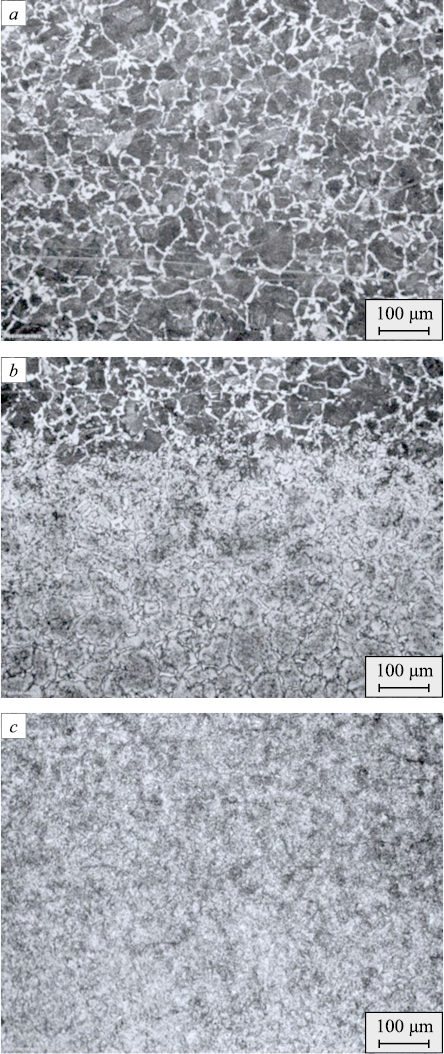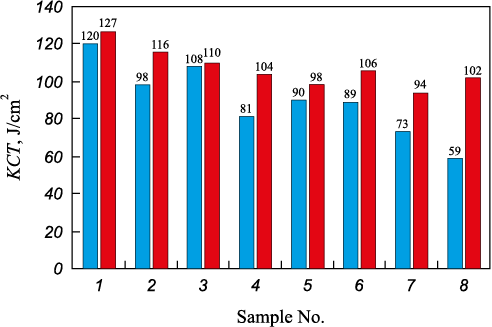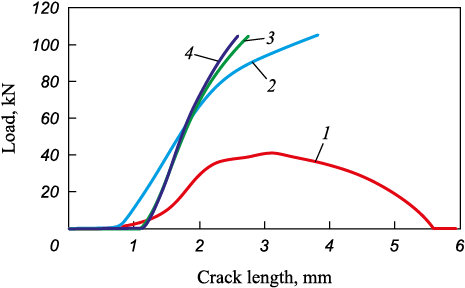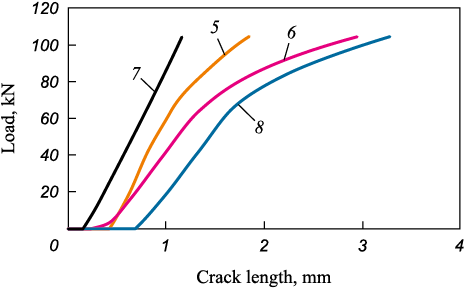Scroll to:
Changes in structure, hardness and crack resistance of plasma-strengthened steel 65G
https://doi.org/10.17073/0368-0797-2023-5-516-521
Abstract
The present paper describes the research of structure, hardness and crack resistance indicators before and after plasma treatment of 65G steel of a ploughshare part. As a result of plasma treatment, we obtained the modified layer with increased hardness in the range of 980 – 3558 HV with increase in 3.6 times. Metallographic studies showed that pearlitic-ferritic structure of the original metal transforms into needle martensite with high hardness and strength due to plasma hardening. It is recommended to determine the impact toughness by the Drozdowski method, in which a fatigue crack is pre-created on a special vibrator. Also, before the fatigue crack was grown, lateral V-shaped notches of different depths were made on the sample lateral surface. The relative crack length, λ, varied from 0.27 to 0.65. According to the results of compression tests, it was found that there was a small movement of cracks in the hardened samples in the range from 1.3 to 5.6 mm. The initial unstrengthened samples are in a more brittle state than the quenched ones, and accordingly, significant fracture is observed in the conditions of artificial cracking. The evaluation of 65G steel samples for crack resistance by impact bending tests with subsequent oscillographing showed that plasma hardening inhibits crack growth by increasing impact toughness. Thus, the use of plasma hardening is effective in surface hardening of 65G steel, in particular ploughshares which are constantly exposed to mechanical stresses, friction and wear.
Keywords
For citations:
Kossanova I.M., Kanayev A.T., Tolkynbayev T.A., Jaxymbetova M.A., Sarsembaeva T.E. Changes in structure, hardness and crack resistance of plasma-strengthened steel 65G. Izvestiya. Ferrous Metallurgy. 2023;66(5):516-521. https://doi.org/10.17073/0368-0797-2023-5-516-521
Introduction
In Kazakhstan today, efforts are underway to enhance the quality of machinery and components through studies focused on the strength properties achieved by employing plasma hardening techniques on heavily stressed parts. The use of the promising method of plasma treatment appears rational for enhancing strength parameters, such as hardness, wear resistance, and crack resistance [1; 2]. This method impacts solely on the surface layer of the components, avoiding deformation of the metal and facilitating the creation of a modified layer exhibiting high strength characteristics on the product’s surface. Alterations in the structure and properties of the surface layer take place under conditions of ultra-rapid heating and cooling rates (ranging from 103 to 105 K/s) and brief exposure to the processed material [3 – 5].
Materials and methods
The research focused on studying steel 65G, specifically the ploughshare component of a plough, designed to slice through soil layers and consistently subjected to friction and wear [6; 7].
Templates were cut using a Labotom-3 cutting machine from Struers (Switzerland). Throughout the cutting process, both the sample and cutting disc were cooled using water and a specialized lubricant to prevent oxidation [8; 9]. Following the cutting of appropriately sized samples, the steel’s chemical composition was analyzed to determine the presence of additives, utilizing a Niton XL2 X-ray fluorescence analyzer (Table 1).
Table 1. Results of spectral analysis of 65G steel samples
|
Plasma hardening was performed using a UDGZ-200 plasma hardening facility. This facility operates by employing indirect plasma arc technology, enabling the heating of a 1 – 2 mm surface area without causing internal deformations to the components [10 – 12].
The steel surface was examined using a Carl Zeiss metallographic microscope with a 200× magnification level.
The surface hardness of the samples was measured using a Wilson VH 1150 Vickers hardness macro tester, employing an indenter load of 30 kg.
Impact bending tests were conducted following the guidelines outlined in State Standard GOST 9454–78, incorporating measurements of impact strength. This method involves the deliberate initiation of sample fracture at a point of concentration in the middle by a single strike from a pendulum pile driver. Impact tests were performed using a KM-30 pendulum impact driver, employing impact samples sized at 6.5×11.5×55 mm. To induce fatigue cracks on the samples, a Drozdowsky vibrator was utilized, resulting in a relative crack length λ ranging from 0.27 to 0.65 [13 – 15]. Evaluation of impact strength under assured plane deformation conditions was conducted on samples featuring two additional lateral V-shaped notches, each with a depth of 1.0 mm. This assessment of impact toughness on notched samples allows for the determination of the specific work involved in crack propagation during fracture under plane-strain state (PSS) conditions [16 – 18].
Results and discussion
Metallographic examinations have revealed that the mechanical attributes such as strength, hardness, and crack resistance of plasma-hardened components are influenced by the configuration, dimensions, and alignment of subgrains (Fig. 1).
Fig. 1. Metallographic structure of 65G steel after surface plasma hardening: |
The structural-phase analysis indicated that the initial metal comprises pearlite grains and ferrite. However, through the process of plasma hardening, these structures undergo a transformation into acicular martensite, exhibiting heightened hardness and improved crack resistance [19; 20].
Material hardness measurement
Table 2 outlines the outcomes of hardness measurements conducted both before and after the plasma treatment of 65G steel.
Table 2. Results of hardness measurements on the surface of 65G steel samples
| ||||||||||||||||||||||||||||||||||||||||||||||||||||||||||||||||||||||||||||||||||||||||||||||||||||
The data presented demonstrate a notable elevation in the hardness of 65G steel resulting from plasma quenching. The average hardness value before and after hardening was derived from three measurements for each sample, showcasing an approximate 3.6-fold increase in hardness.
Following the plasma hardening process, the crack resistance of the steel was evaluated via impact bending tests accompanied by oscillography. The impact strength of the hardened samples was recorded as 127, 116, 110, 104, 98, 106, 94 and 102 J/cm2.
Fig. 2 illustrates the findings of impact strength studies correlating with crack length. Notably, a gradual escalation in impact toughness is observed as the initiator crack length increases.
Fig. 2. Dependence of impact strength on crack length (samples 1 – 8) |
Using the outcomes from fracture analyses, the primary dynamic test characteristic, impact strength KCT, was calculated.
Fig. 3 displays the assessment results of impact toughness for 65G steel samples before and after plasma hardening. A dynamic growth of KCT following plasma quenching is evident, signifying its role in impeding further crack propagation by elevating the KCT. Consequently, the original samples exhibit a comparatively more brittle state than the quenched ones, highlighting a substantial vulnerability to failure under plane deformation conditions [21; 22].
Fig. 3. Diagram of dynamic crack resistance of initial ( |
During the compression testing of samples under a linear load of up to 120 kN, crack displacement within the range of 1.3 – 5.6 mm was observed (Figs. 4, 5).
Fig. 4. Cracks’ length at linear load (hardened samples 1 – 4)
Fig. 5. Cracks’ length at linear load (hardened samples 5 – 8) |
The observed crack movement led to a slight reduction in the live cross-sectional area of the sample. Consequently, an increase in the work of fracture (Ap ) is evident (Fig. 4, 5).
Conclusions
Metallographic examinations conducted on 65G steel revealed that upon plasma hardening of its surface within a hardened zone of 2 mm thickness, a gradient-layer structure with varying hardness spanning from 980 to 3558 HV is formed. This process induces a notable increase in microhardness, reaching up to 3.6 times, a significantly higher enhancement compared to other hardening methods. For example, electric plasma hardening resulted in an increase in hardness by 2.16 times.
Investigations into impact toughness and the behavior of impact-induced cracks indicated that plasma arc hardening effectively impedes the dynamic expansion of cracks within the surface layer.
Thus, the study outcomes affirm the viability and effectiveness of employing plasma arc hardening as a means to fortify the surface layer of heavily stressed components, specifically exemplified in the case of 65G steel.
References
1. Kossanova I.M., Kanayev A.T., Jaxymbetova M.A., Akhmedyanov A.U., Kirgizbayeva K.Zh. Effect of electrolytic-plasma surface treatment on structure, mechanical, and tribological properties of grade 1 wheel steel. Metallurgist. 2022;66(7):69–73. https://doi.org/10.1007/s11015-022-01393-0
2. Korotkov V.A. Influence of plasma quenching on the wear resistance of 45 and 40X steel. Russian Engineering Research. 2016;36(11):916–919. https://doi.org/10.3103/S1068798X16110125
3. Kanayev A.T., Jaxymbetova М.А., Kossanova I.М. Quantitative assessment of the yield stress of ferrite-pearlitic steels by structure parameters. News of the National Academy of Sciences of the Republic of Kazakhstan. 2021;3(447):65–71. https://doi.org/10.32014/2021.2518-170X.64
4. Xiang Y., Yu D., Cao X., Liu Y., Yao J. Effects of thermal plasma surface hardening on wear and damage properties of rail steel. Journal of Engineering Tribology. 2017;232(7): 787–796. https://doi.org/10.1177/1350650117729073
5. Jaxymbetova M., Kanayev A., Kossanova I., Mazur I., Akhmedyanov A., Kirgizbayeva K. Improvement of the mechanical properties of reinforcing bar steel by combined deformation-heat treatment. International Review of Mechanical Engineering. 2022;16(9):460–466. https://doi.org/10.15866/ireme.v16i9.21521
6. Toktarbayeva G.M., Аlpysbayev S.K., Rakhadilov B.K., Satbayeva Z.K., Zhaparova M.S. Effect of electrolyte-plasma surface hardening on the structure and properties of 40KhN steel. Vestnik VKGTU. 2020;87(1):200–205. (In Russ.).
7. Petrov S.V., Saakov A.G. Technology and equipment for plasma surface hardening of heavy-duty parts. Materials and Manufacturing Processes. 2017;17(3)363–378. https://doi.org/10.1081/AMP-120005382
8. Korotkov V.A., Ananyev S.A., Shekurov A.V. Investigation of the effect of the cooling rate on the structure and mechanical properties of metal in plasma quenching. Welding International. 2014;28(2):140–142. https://doi.org/10.1080/09507116.2013.796665
9. Q’Donnelly B.E., Reuben R.L., Baker T.N. Quantitative assessment of strengthening parameters in ferrite-pearlite steels from microstructural measurements. Metals Technology. 2013;11(1):45–51. https://doi.org/10.1179/030716984803274837
10. Ramazanova Zh.M., Kirgizbayeva K.Zh., Akhmedyanov A.U., Jaxymbetova M.A. Influence of the process of microplasma treatment in electrolyte solutions on the oxide coating properties. International Journal of Mechanical Engineering and Technology. 2018;9(12):709–721.
11. Yong X., Yu D., Li Q., Huabei P., Xiuquan C., Jin Ya. Effects of thermal plasma jet heat flux characteristics on surface hardening. Journal of Materials Processing Technology. 2015;226(12):238–246. https://doi.org/10.1016/j.jmatprotec.2015.07.022
12. Bespalova A., Lebedev V., Florenkova O., Knysh A. Increasing efficiency of plasma hardening by local cooling of surface by air with negative temperature. Eastern-European Journal of Enterprise Technologies. 2019;4(12):52–57. https://doi.org/10.15587/1729-4061.2019.176825
13. Yan M.F., Chen B.F., Li B. Microstructure and mechanical properties from an attractive combination of plasma nitriding and secondary hardening of M50 steel. Applied Surface Science. 2018;455:1–7. https://doi.org/10.1016/j.apsusc.2018.04.213
14. Esfandiari M., Dong H. Plasma surface engineering of precipitation hardening stainless steels. Surface Engineering. 2006;22(2):86–92. https://doi.org/10.1179/174329406X98368
15. Martynov V., Brzhozovsky B., Zinina E., Yankin I., Susskiy A. Fluctuations in the process plant as a quality assessment criterion of low-temperature plasma hardening process. Procedia Engineering. 2017;176:451–460. https://doi.org/10.1016/j.proeng.2017.02.344
16. Semboshi S., Iwase A., Takasugi T. Surface hardening of age-hardenable Cu–Ti alloy by plasma carburization. Surface and Coatings Technology. 2015;283:262–267. https://doi.org/10.1016/j.surfcoat.2015.11.003
17. Lebrun J.P. Plasma-assisted processes for surface hardening of stainless steel. Thermochemical Surface Engineering of Steels. 2015;6(16):615–632. https://doi.org/10.1533/9780857096524.4.615
18. Оkolovich G.A., Sharikova T.G., Petrova E.V. Increasing durability of the tool under mutual influence of wear and fatigue of steel. Polzunovskii vestnik. 2015;(2):33–36. (In Russ.).
19. Rasshupkin V.P., Akimov V.V. Fatigue strength and wear resistance of high manganese steel. Omskii nauchnyi Vestnik. 2006;35(2):78–80. (In Russ.).
20. Mohd I., Zahari T. Surface hardening of tool steel by plasma arc with multiple passes. International Journal of Technology. 2014;5(1):79–87. https://doi.org/10.14716/ijtech.v5i1.156
21. Zhao K., Yan G., Li J., Guo W., Gu J., Li Ch. The resistance to wear and thermal cracking of laser surface engineered P20 steel. Metallic Materials. 2023;13(1):97–105. https://doi.org/10.3390/coatings13010097
22. Medina L., Marcus V.T., Paschalidou M., Lindwall G., Riekehr L. Enhancing corrosion resistance, hardness, and crack resistance in magnetron sputtered high entropy CoCrFeMnNi coatings by adding carbon. Materials and Design. 2021; 205:109–121. https://doi.org/10.1016/j.matdes.2021.109711
About the Authors
I. M. KossanovaKazakhstan
Indira M. Kossanova, Master Student, Doctoral
62 Zhenis Ave., Astana 010000, Republic of Kazakhstan
A. T. Kanayev
Kazakhstan
Amangel’dy T. Kanaye, Dr. Sci. (Eng.), Prof. of the Chair of Standardization, Metrology and Certification
62 Zhenis Ave., Astana 010000, Republic of Kazakhstan
T. A. Tolkynbayev
Kazakhstan
Temirkhan A. Tolkynbayev, Dr. Sci. (Eng.), Prof.
2 Satpaeva Str., Astana 010008, Republic of Kazakhstan
M. A. Jaxymbetova
Kazakhstan
Makpal A. Jaxymbetova, Senior Lecturer
2 Satpaeva Str., Astana 010008, Republic of Kazakhstan
T. E. Sarsembaeva
Kazakhstan
Tolkyn E. Sarsembaeva, PhD, Senior Lecturer
62 Zhenis Ave., Astana 010000, Republic of Kazakhstan
Review
For citations:
Kossanova I.M., Kanayev A.T., Tolkynbayev T.A., Jaxymbetova M.A., Sarsembaeva T.E. Changes in structure, hardness and crack resistance of plasma-strengthened steel 65G. Izvestiya. Ferrous Metallurgy. 2023;66(5):516-521. https://doi.org/10.17073/0368-0797-2023-5-516-521





































